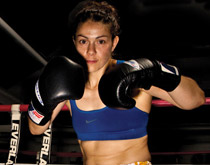“Mighty” Melissa McMorrow, a top-10 boxer in all major sanctioning bodies, is preparing for the fight of her life. But she’s not in a ring. She’s frozen in time, crouched low like Rodin’s The Thinker, a silhouette against San Francisco’s pomegranate dusk. The pain is about to come—300-yard suicides, 200-meter sprints, treks up the mini-cliffs that masquerade as city streets.
Before she moves a muscle, she’s swallowed by silence. No iPod. Just silence. This is when she must choose. How far am I willing to go today?

The secret of boxing is that it’s not really about boxing. The booming knockout blows are an aberration. It’s not about who punches the hardest, but who punches the smartest. In a way, it’s about architecture, something McMorrow knows well. She graduated from Carnegie Mellon in 2004 with a degree in that field. It was there, before she ever laced up the gloves, that she learned her first boxing lesson: “Don’t just work hard, work smart.”
She builds her temple, brick by brick, in the fading light. She has to, because the opponent awaiting her for the WBA Flyweight Championship, Arely Mucino, will tower over her. At just 4-foot-11 and 112 pounds, the 30-year-old McMorrow is often older and shorter than her adversaries, so she makes up for it the only way she can, by outlasting them.
It’s somewhat coincidental that McMorrow is fighting at all, let alone for the upcoming championship belt in Guadalajara, Mexico. Upon graduation from CMU, the All-American soccer player moved to the Golden State for work. She earns a steady paycheck from SolarCity, where she is in charge of coordinating commercial accounts for the clean-energy provider. One night, a friend suggested they check out a boxing club nearby. “I always wondered if I could win a fight,” McMorrow says, “so I decided to try it.” She won and has kept winning. Boxing has taken her to the bright lights of San Jose’s HP Pavilion, the Playboy Mansion, New York City’s Times Square.
But none of those big-city lights matter now. What matters is this dying light, this silence. This is when McMorrow leaves her day at the office behind her, when she visualizes her opponent’s advantage in height and reach, when she channels a serene kind of fury. This is when she starts fighting.
When the bell rings in Guadalajara, she comes out swinging, raining down a maelstrom of punches. The fight leaves the Mexican announcers breathless after a hurricane of rolled-Rs and raspy exclamations. Neither fighter gets knocked out, but McMorrow loses in what many ringside observers consider a controversial split decision.
McMorrow flies home to San Francisco, walks into the office Monday morning, sporting bruises, and sits quietly at her desk. She’ll make conference calls with a sore jaw. And when everyone leaves for happy-hour margaritas, she’ll grab her backpack and head for the steep hills instead. McMorrow knows this secret, too, about boxing. It’s not about knockouts, it’s about getting back up.



